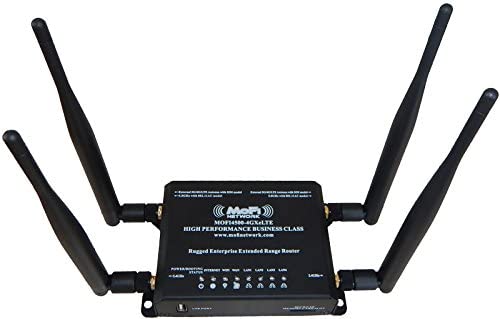I've since thrown away most of this setup and gone with a new setup described in a new post. So this is just here for posterity.
(Content last updated 7/16/2020)
People ask us all the time what we use for internet access on the boat. It's a vaguely complicated setup, so I figured I'd write it up in case others want to follow in our footsteps (or even better, have suggestions!)

The central router on the boat is a Cradlepoint COR IBR1700. It serves the wifi network on the boat that everything, including our cell phones, connect to. I've set it up to run off the 12V on the boat through a dedicated breaker switch that we leave on 24/7. The unit comes with an integrated dual-antenna (2x2 MIMO) cellular modem with two SIM card slots, or you can get the four-channel version if you have a 4x4 MIMO antenna (rare). You can add a second modem to it with an additional two SIM card slots, and if you have the antennae for it, you can split your usage between the two modems.
We've struggled with the unit since we got it, due to various bugs in the firmware affecting us. However, with a firmware update on 7/15/2020, they finally appear to have fixed the crash-reboot issue, and we can finally re-enable carrier aggregation and not have crashes every few hours! In the middle of the night in central Maine, I actually measured some crazy bandwidth numbers, using AT&T:

Our backup router is a MOFI4500. It only has one SIM slot, so you're manually swapping SIM cards to change networks. It only has a single cell modem, which is slower than the Cradlepoint's cell modem, and the Wifi is slower as well. But not by much. It's also cheap and just works. For most boaters looking to get a reliable cell internet connection on their boat, this is what I tell them to get.

The biggest piece of our connectivity puzzle is the antenna. We started with a WirEng GigaMIMO Lite, and while it was an improvement over just tethering, we wanted more, so we upgraded to the full GigaMIMO recently, and it was a pretty big boost. Both GigaMIMO units are 2x2 MIMO antennae, which means it's basically two antennae in one, with orthogonal polarization, so they send non-intersecting wavelengths, for double the bandwidth (if you have a router that supports plugging in two antennae.) After upgrading, we now regularly get several megabits of internet when our cell phones show zero coverage or are just squeaking by on 1x. We have only lost connectivity in the absolute boonies for a few minutes on one day of the trip so far. The full unit is nearly 3000$, though, so you have to really want that internet to justify it, as well have somewhere to put what's basically a 3 foot cube of antenna with an unobstructed-by-metal view of the horizon. But in even moderate connectivity, when the cell phones in our pocket are struggling, we usually have 15-30 megabits of download, and in good areas, we've cracked 160 before.

For actual data plans, we burn through huge amounts of data between work, gaming, streaming, and general browsing. We regularly use hundreds of gigabytes a month, which is far more than the standard plans will give you, so I had to get creative. We have three SIM cards on the boat: AT&T, Verizon, and Google Fi. The AT&T plan is through NoLimitData, and is a nearly unlimited plan (no throttling, 500GB a month limit). The Verizon SIM is a no-longer-available prepaid truly unlimited plan (no throttling, no limits), though you can get something similar through UnlimitedVille. The Google Fi SIM is our backup plan and lightweight international roaming solution, but it caps out at 22GB/month before you're slowed to a crawl.
On our great loop trip so far, AT&T has usually had better bandwidth than Verizon, so it tends to be our default active SIM. I don't yet have a solution for when we get to Canada, but that doesn't appear to be in the cards until 2021, so we'll see if things change by then. There currently don't seem to be any actual unlimited plans there, no matter how much money you're willing to pay, so we'll cross that bridge in a few months as it gets closer.

Lastly, if wifi is available anywhere remotely nearby, we have a Wave Wifi Rogue Pro wifi booster on top of the boat, across from the LTE antenna. This works okay if there's wifi within a mile or so, though we've gotten signals several miles away before under perfect conditions. Under almost all conditions on the loop, though, our cellular setup works so much better than even good marina wifi that we don't even bother using this. We've only bothered I think once on the trip so far, and it was merely academic, while I was debugging some issues with the Cradlepoint's cell modems. I expect we'll be relying on this a lot more in Canada, given the likely no-unlimited-data solution we'll run into there. More and more marinas are moving to 5Ghz-based wifi as well, which our unit doesn't support, so I'm looking to replace this with something new soon.